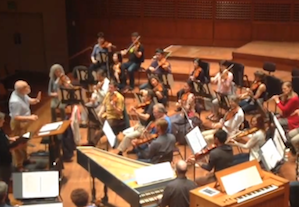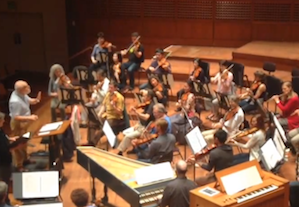
A period of intense Bach immersion at the San Francisco Symphony came to a close last weekend, with performances of J.S. Bach’s festive secular cantata No. 207a from 1735 Auf, schmetternde Töne der muntern Trompeten (Come, resounding tones of merry trumpets), plus the Missa (or missa brevis) from 1733, which consists only of settings of the Kyrie and Gloria. Bach would expand this ‘short mass’ into a musical setting of the Latin Ordinary that became his Mass in B Minor BWV 232 in 1749, the year before his death.
Over the past two weeks, SFS musicians and chorus members have been working with Dutch guest conductor Ton Koopman to see the great German composer through the eyes of a Bach scholar, learn why he considers Bach the center of his musical world, and share this experience in concert with a very appreciative San Francisco audience.
Koopman has the ability to make a modern symphony orchestra behave and sound very much like a period ensemble. ... He leaves no detail unattended and the changes he brings about are quite astonishing.
As the first concert series made abundantly clear, Koopman has the ability to make a modern symphony orchestra behave and sound very much like a period ensemble. In the process, he leaves no detail unattended and the changes he brings about are quite astonishing.
The second series of concerts included the Symphony Chorus, prepared by director Ragnar Bohlin, plus a quartet of outstanding vocalists: American soprano Teresa Wakim, Polish mezzo Bogna Bartosz, German tenor Tilman Lichdi, and his fellow countryman, bass Klaus Mertens.
These four singers each have an extensive period performance background and they have worked with Koopman and his Amsterdam Baroque Orchestra in the past, but these concerts marked their SFS debuts.
During the few passages in the secular cantate that they actually performed as a quartet, the recitativo and the festive closing chorus August lebe (Long live Augustus), their operatic interplay was delightful and wonderfully balanced.
The cantata also held some truly astonishing vocal one-on-one interactions, for instance when bass (Mertens) and soprano (Wakim) exchanged some of the vapid laudations and forgettable pleasantries that an unknown librettist penned in celebration of the name-day of Polish king Augustus III (1696-1763).
Contrary to many (if not most) of Bach’s cantatas, knowing the text doesn’t really help to enjoy the lovely music of this one, even though Klaus Mertens’ impeccable diction allowed us to understand every word and syllable he sang.
This was less the case with the Symphony Chorus. Versatile as the ensemble is, it is still a choir of symphonic proportions. At more than twice the size of Koopman’s own Amsterdam Baroque Choir, it is by definition less a ‘period’ instrument. Given the fact that it is pretty much impossible to make sixty voices sound like a choir of 24, Koopman and the Symphony Chorus achieved a remarkable degree of ‘baroque lightness’, as the Missa showed after intermission.
The past two concert series under Koopman have shown how, and to what extent a specific guest conductor can shape the sound of an orchestra. This week, the San Francisco Symphony and Chorus are moving on to repertoire that is vastly different than Bach.
It may not be noticeable when SFS plays Brahms, Bartók and Sibelius, but there is no doubt that two weeks of Bach immersion will have a lasting effect on the ensemble. And the resulting concerts will certainly be a lasting memory.

